Hawaiian South Shore November 2020 Newsletter
Share
NEWSLETTER NOVEMBER 2020

Looking Back on 25 Years of Hawaiian South Shore
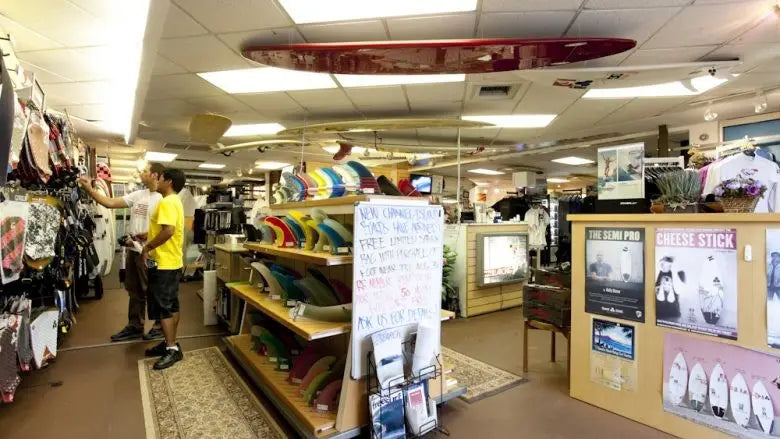
This November marks the 25th anniversary of Hawaiian South Shore, a business that holds a special place in my heart. It has become so much more than a surf shop for me; it is a passion, a community, and a family. Over the years, I have celebrated some of my happiest memories with the Hawaiian South Shore ohana. As I look back at 25 years with you all, I’d like to share the story of how Hawaiian South Shore came to be and some of my favorite milestones here.
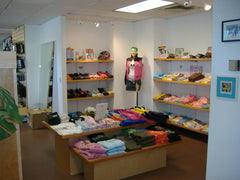
As many of you know, my story starts with my grandmother. She had to find a way to support our family because my grandfather took off and left her to fend for all of us. She knew that a normal job wouldn’t work for her, so she got creative and started selling hardware on the street. Eventually she moved her business into a shop and began selling used clothes to the military people in town.
I remember going into the clothing shop and hanging out there, watching the GIs who came in and seeing my grandmother as she ran her business. Looking back, I can see that this was a formative time for me. I dreamt of owning my own business and even had my own little desk where I would play and pretend I was the CEO of a company.
The military scene had an influence on me, too. My dad was a Marine and I eventually joined the military as well. I was stationed in Yokosuka, then in Hawaii. Once I got out of the military, I started working in the civilian sector in Hawaii. I took a job as the general manager of a small division of a larger company here on Oahu, then moved on to another job at Atlantis Submarines. I built up a 401k before eventually cashing it out for seed money when I decided that I was ready to fulfill my dream and start my own business.
At first I thought I wanted to start a restaurant, but after volunteering at a Japanese place, I realized that the food industry was a tough business to crack. I had just gotten into surfing at the time and decided that, instead of a restaurant, I would start a surf shop. My friend Wendell Kong was very influential in my surfing life by showing me the ropes and helping me understand boards; he would eventually provide one of my earliest contacts in the surf industry.
When I first started Hawaiian South Shore, I didn’t know much about retail – and
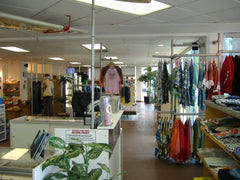
I also didn’t have a lot of investment money. I decided I would have to build the shop myself. Well, with the help of my friend Mark Lambert, I did just that. We went to someone’s house, gathered a bunch of bamboo, and that’s what we built the store out of! I wasn’t really skilled in woodworking, so the shop looked pretty DIY at the beginning! A few years later, we reinforced the store with metal pipes to provide stability and a more industrial look. Eventually we were able to hire professionals to do a completely new build which still stands today.
The surf industry was a lot more insular and competitive than I had anticipated. At first, I struggled to persuade brands to sell through my store. Many of them were being sold in other stores in Town which were pressuring those brands to not let my shop stock them. Those early years were a struggle, so I had to get creative. I ended up shifting gears and stocking outlet clothing. Then I realized that the skateboarding scene was booming and a lot of surf shops were actually crossover surf/skate shops, so I decided to do the same and started focusing on skate sales.
We ended up creating our own skate brand, 320SS, and got design help from a guy who had done brand design for Stussy. That helped 320SS get a foothold in the skate industry and we were soon working with major skate shoe brands such as Etnies, DC, and Nike.
Our first big break came a short time after when we started selling Soap Shoes. We ended up being number one in sales for the West Coast/Hawaii region and received a bunch of publicity, including features in Hawaiian Moving Company and CNN.
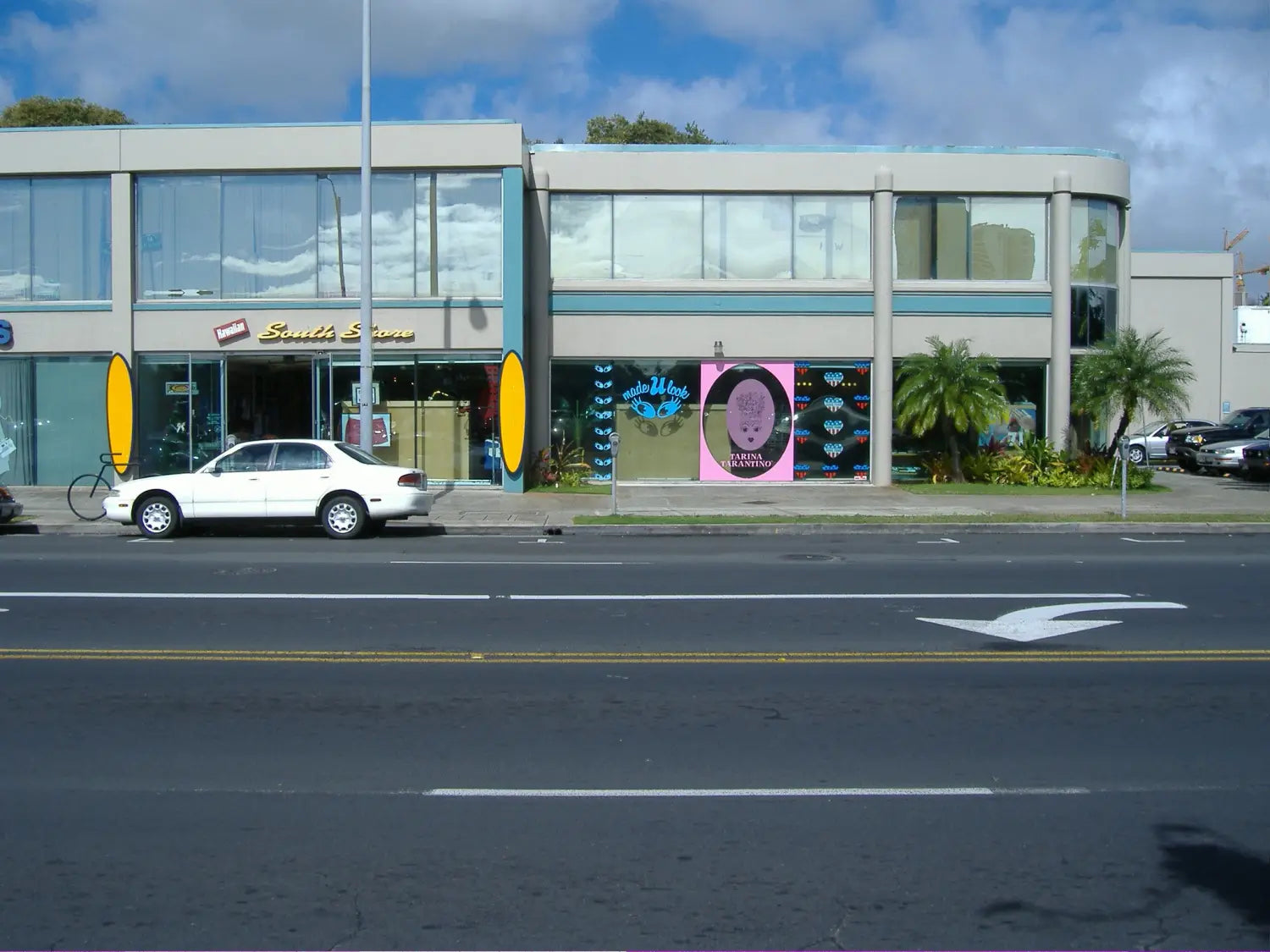
As we strengthened our presence in the skate scene, we also decided to branch out and start selling motorized scooters. These were sort of like the Razors that kids ride today, except they had gas-powered, two-stroke motors and could go really fast! We sold a ton of them and ended up making waves in Honolulu – the city noticed how many people were zooming around on them and ended up banning them on the sidewalks!
Eventually we transitioned more heavily into surf, which was the main goal from the beginning. We had been selling surf gear the entire time, but because the industry was so challenging to break into, it didn’t become our main focus for the first few years. However, Wendell Kong eventually got us connected with the legendary local shaper Wade Tokoro; that really gave us our start when it came to legit brand sales. Wade was tied to another shop, but he ended up putting a few boards in our shop and they sold really well.
At the same time we connected with Matt Biolos and …Lost, so we ended up stocking them in our shop. Their round-nose fish was really popular with both local and Japanese surfers and we were soon stocking and selling tons of …Lost boards. This would grow to be one of our biggest and longest-lasting partnerships. Matt has come to Oahu twice for meet-and-greet events and I’ve been really impressed by his professionalism. Even after being at the shop all day long and with his family getting antsy and wanting to leave, he stayed until he’d had the chance to talk with everyone who wanted to order a board and hammer out their dimensions. He was here until after 9:00 pm!
Eventually we also picked up JC surfboards and started working with Pat Rawson, then got in touch with Simon Anderson and started stocking his boards too. As our reputation and stock grew, more and more brands were willing to work with us. I began to feel like we were finally “making it” in the surf industry and the local surf scene. Pat came down to do a meet-and-greet at the shop and even gave us a board that Kalani Robb had been riding, which we ended up hanging in the store!
Being located in Town, just a few blocks from Ala Moana and Waikiki, it was only a matter of time before we got into longboards. They were just beginning to make a comeback and we started focusing on them at exactly the right time. We were working with a guy who ran a noseriding contest and he suggested that we reach out to Hap Jacobs, a legend in the longboard shaping scene. Hap visited the shop for a meet-and-greet event and we were soon stocking his boards and helping to resurrect the “forgotten” art of longboarding. We also started working with Donald Takayama, another legend of longboarding, and before long we were stocking his boards too.
We ended up working with a number of other legendary surfers and shapers over the next couple of years. Randy Rarick would bring boards down now and then, so we always kept a stock of his shapes on hand. Then we partnered with Dick Brewer, who ended up shaping two special Hawaiian South Shore models – a round-nosed fish for small waves and a pulled-in fish shape for more powerful waves. Collaborating with Brewer was such a pleasure and an honor. I was able to spend time with him in the shaping bay, talking story and learning from him about the various aspects of surfboard design. This influenced me to seek out more shapers and, over the years, I spent a lot of time talking with board builders and learning everything I could about board design.
We stocked and sold a lot of Joel Tudor’s boards before he moved on to Kookbox in New York. During that time I worked with Joel’s mom. We also made Joel’s wetsuits in the US and sold them for a few years. Somehow during all this we were introduced to Andy Davis through Joel or his mother and ended up doing some exclusive Andy David HSS T-shirt design.
On the 30th anniversary of Simon Anderson unveiling the thruster at maxing Bells Beach, he visited the shop for an event, which was really exciting for us. Simon spent time chatting with a bunch of our customers and even did some board orders for the local crew.
These days, we have become the exclusive dealer for a large number of surfboard brands in Hawaii including Thunderbolt, which has been a great collaboration for us. One of our shop’s team riders mentioned Thunderbolt to me and, after I reached out to the crew there, we ended up stocking their boards and being really impressed by their program. CJ Nelson, Ben Skinner, Harley Ingleby, and Taylor Jensen have all stopped by for events and we were super excited when local boy Kai Sallas also joined the Thunderbolt team.
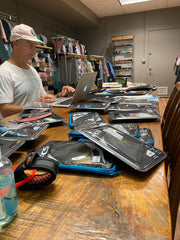
Keoni Watson from FCS was the person who helped us connect with Firewire; these days, we’re working very closely with them. We had already sold out of our stock due to pre-orders before the first Firewire boards even arrived in our shop. The Firewire guys were impressed so the company’s founder came to Oahu to meet up with us and deepen our relationship. We’re now a premier dealer with them and typically get their new boards the first day they launch, at the same time that the mainland shops get them. That’s a pretty big deal for us, as Hawaii is often behind when it comes to getting new stock. Firewire also invited Hawaiian South Shore to come to Kelly Slater’s Surf Ranch with them. I was able to go and ride the wave there while spending time with the Firewire team, which was one of the most exciting things I’ve done in recent years! Our partnership with Firewire has really blossomed over the years and we really value working with them.
Of course, Hawaiian South Shore hasn’t just been about selling boards! We’ve developed a great community over the years and have enjoyed giving back as much as possible while hosting a variety of events. One of our biggest was a vintage surfboard auction that we did in collaboration with Vissla and Randy Rarick. Randy really worked overtime on that event. The day before, he was at the shop from 2:00 pm until 11:00 pm setting everything up. Then, on the day of the event, he drove to Town from Sunset Beach at 7:00 am and stayed until it ended at 6:00pm! I talked to one of the policemen who was directing traffic and parking for that event; he said that more than 800 people showed up for it! There were even a bunch of old vintage cars on display. What a great memory!
We also did a fashion show with a live band and we hosted movie nights every weekend for a year. We would block off our parking area and set up a 20-foot screen to project films. Jim from Rainbow Drive-In would come and serve food at the events, even premiering new menu options for our guests! We usually had between 20-30 people show up for the movie nights - although sometimes, when we also had prize giveaways, there were as many as 60-70 people in attendance. Jim and his team from Rainbow Drive-In were always there, making sure everyone was happy and well-fed!
I actually got to know Jim through another project that was hosted by the Chamber of Commerce in Chigasaki, Japan, which is a sister city of Honolulu. Every year Chigasaki would host a Hawaii Festival and I would go over with a bunch of limited-edition products to display and sell. Jim and the Rainbow Drive-In would also go and make Loco Mocos for the attendees. We went to the festival four years in a row and that’s how Jim and I became friends.
Jim also brought his team to help out with a bunch of community service projects that we hosted here at Hawaiian South Shore. They’ve helped with a blood drive and a number of food drives. One year I actually couldn’t be there for the food drive, so Jim ran the whole thing himself. They collected food from people who wanted to donate, then packed it all up on palettes and stored it until the food bank could come and pick it up.
Over the years we have definitely faced a number of challenges here at Hawaiian South Shore. SARS and 9/11 both severely affected business, but then again, 9/11 affected everyone. I remember lots of tourists were stuck on Oahu after 9/11, so we did our best to work with them and help them through the difficulty of being stuck far from home.
COVID-19 has obviously been a struggle for us as well, just as it has for the rest of the island. But, despite the challenges we’ve faced here at the shop, it’s the happy memories, the friends, the family, and the community we have developed that I remember the most. As I look back on the past 25 years, I can only hope that the next 25 are just as satisfying, joyful, and full of friendship and love. Thanks for helping make Hawaiian South Shore the success that it is!
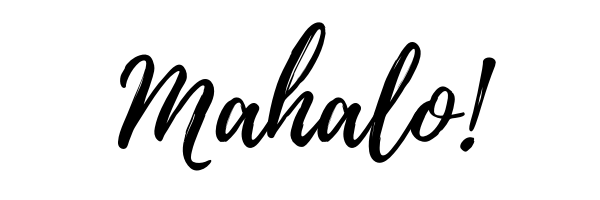
Kai Sallas, Tommy Maus, and Thunderbolt: Shaping the Future While Learning from the Legends of the Past
The majority of our surfing accessories have become standardized and mass-produced, but surfboard shapers are still an integral part of the surfing experience, which is pretty cool. Most other sports have their gear (bikes, skis, snowboard, etc.) created by machines, but many surfboards still have an element of human involvement in their creation, which makes them equal parts art and technology. No wonder that surfboard shapers have held an almost mythical status for us over the years—often drawing on decades of experience to craft the finest boards possible.

While there are a handful of big-name shapers that get most of the attention, there are thousands of other board builders who are equally as talented, but who don’t necessarily enjoy as much of the limelight. Many of them shape their own boards, and also ghost shape for the big name brands. Ghost shaping is essentially the process of having another shaper shape boards under your name and designs. So for instance, while Al Merrick his and Channel Islands Surfboards have been a huge name in the surfboard industry for four decades, and while Al is involved in the design of all of his board models, he doesn’t actually shape all of the boards that come out of his factory. The brand has gotten so big that this wouldn’t actually be possible! Instead, he has a number of ghost shapers who work for him and shape boards out of his designs, under his label and name.
Most of the biggest shapers have ghost shapers, and ghost shaping is a great way to get a start in the industry. Donald Takayama was looking for help with his brand in the mid-1990s, and ended up calling on Tommy Maus to help expand his brand into California and Florida. Maus had already been shaping professionally for 20 years. He started as a sander in Santa Cruz, sanding boards for Overlin and Doug Haut Surfboards in 1973, then began shaping in 1977 after moving to Florida—helping produce boards for Quiet Surfboards and Natural Art Surfboards. But when he joined Takayama’s team, that’s when his career really took off.
Maus spent 16 years shaping under Takayama, learning his secrets and his attention to detail. Eventually, Takayama suggested that Maus take over the Hawaii Pro Designs in Oceanside. In the meantime, Maus had developed a relationship with Takayama team rider Kai Sallas. A staple of Hawaiian longboarding and the 2018 ISA world champion, Sallas has long been a leader and innovator when it comes to both performance on and design of longboards. Drawing on the influence of his years with Takayama, Sallas eventually developed his own line of designs with Maus, and together they launched the designs under in Thunderbolt construction.

Today, the boards created through the Kai Sallas/Tommy Maus/Thunderbolt collaboration represent a combination of timeless influences such as Donald Takayama and the futuristic construction technology of Yu Sumitomo. The resulting quiver includes some of the best longboards on the market.
Training and Preparing for Big Wave Season With Hawaiian South Shore’s Matt Rott – Part 1

Hawaiian South Shore’s writer and editor Matt Rott is also our resident big-wave guy. He has spent the past 20 years chasing swells around the world, featuring in and contributing to just about every magazine in circulation. Around 10 years ago Matt became a staff writer at Magicseaweed, where, in addition to covering world tour events and industry activities, he has attended most of the big wave tour events over the past five years, caddied for Jamie Mitchell the year he won Nazare, and had numerous entries into the Big Wave Awards. Matt has surfed just about every marquee big wave on the planet, including Jaws, Maverick’s, Todos Santos, Puerto Escondido, Nazare, Punta de Lobos, Pico Alto, and of course Waimea Bay and the North Shore’s outer reefs—and he doesn’t plan to stop anytime soon. To get us ready for the winter season here on Oahu, we asked Matt to give us a breakdown of his preparation for XXL conditions, and talk to us about how to train for big waves.
Over the years I’ve had the opportunity to surf with and observe most of the world’s best big wave surfers—guys like Greg Long, Jamie Sterling, Kai Lenny, Jamie Mitchell, and a host of others. Through all of those hours in the water, I have learned that there are four important areas where you need to be prepared. The first is safety—and that’s something that I’ll talk more about in a follow-up to this article. The other three—which we will focus on today—are physical, mental, and logistics.
Physical preparation: My physical preparation for a big swell happens long before the storm ever shows up on the models. In fact, pretty much everything that I do in life is geared toward preparing me for that handful of days each year when the waves hit the 20-foot+ range. I have a relatively strict, healthy diet that is made up primarily of whole grains, fruits, vegetables, seeds, nuts, and clean sources of protein and fat—no sugar, preservatives, additives, substances of any type, or even meat or dairy (especially in the US, where they are full of hormones and antibiotics). That means no soda, no beer—basically nothing that doesn’t fuel my body and provide it with much-needed nutrients. They way I see it, you’d never pour sugar water into the gas tank of your car, or fill the oil pan with toxic sludge—so why do that to your body, which is far more sensitive and difficult to replace than a car? If you want optimum performance from your body, you have to fuel it properly, and that is reflected in the food that you eat.
Rest is just as important as fuel, so whenever possible I get to bed early and get at least nine hours of sleep per night. There are times when I have to miss sleep to travel to a swell, but in that case I will usually try to arrive a day or two early so that I can catch up on sleep. Again, if your body isn’t adequately fueled (and that includes rest), it doesn’t matter how hard you train—you won’t be able to perform at your best.
In terms of training, the most important thing is to paddle as much as possible. After all, without paddle strength, it is going to be difficult to get into huge waves. Ideally that means surfing (I longboard a ton when the waves are small), but if it goes completely flat, I still try to prone paddle or swim every day when I am at the ocean.
That being said, I also cross-train a ton—probably just as much as I surf. I know a lot of big wave guys are into CrossFit and lifting weights, but I don’t really see much benefit in that. To me, extra muscle that isn’t necessary to help you paddle efficiently is just extra weight—plus it tends to make you less flexible. So I do cross-training that is more focused on my cardio and apnea fitness. I mountain bike a lot, and do a lot of trips to high-altitude areas to get extra cardio benefit. And if I can’t bike, then I’ll try to trail run instead.
I also do a lot of apnea training, to the point where I have a six-minute static hold and a 150-foot free dive. While I don’t ever expect to be held under by a wave for six minutes, I still find that this training helps me stay relaxed during hold downs—and staying relaxed is vitally important, so you don’t panic and burn the oxygen that is being stored in your lungs and cells while you are under water.
Yoga is another important part of my training, as it enhances my flexibility and core strength (which helps my body perform better, and makes it less prone to injuries) and helps me focus more on my breathing. Greg Long once told me that anyone who is serious about big wave surfing but doesn’t practice yoga is kidding themselves.
Mental preparation: When it comes to mental training, I focus on three major activities. The first is apnea. While this is also part of my physical training, there is a certain confidence that I get when I know that I am in peak physical shape and can hold my breath for a long time. So before a swell, I will just take half an hour to breathe and do some static holds, just to demonstrate to myself that I still have it. Knowing that I am prepared physically helps me to be prepared mentally.
I also spend a lot of time doing other activities that push me out of my comfort zone—because I know that when I am out in big waves, that is the headspace I will need to deal with. Rock climbing has become a big part of my training over the past few years, as it forces me to use both my body and mind to overcome challenges in a high-stress environment.
Finally, I do a lot of meditation and introspection, to make sure that I am doing things for the right reason. If I am paddling out with my ego in charge—whether to prove myself to others or to myself—then I am likely to make mistakes. On the other hand, if I paddle out because I genuinely want to be out there and love what I am doing—and if I am in a good headspace about my self-worth, my relationships, and life in general—then I am more likely to make good decisions and perform better. And when you are pushing your comfort level in huge waves, every little bit of extra focus counts.
Logistics: Finally, when it comes to logistics, it is just as important to be prepared ahead of time. The last thing you want to do is show up for a swell and have to scramble to get things ready. If your boards, leashes, vests, food, water, sunscreen, wax, and fins aren’t already laid out and prepared the night before, you are likely to forget something in the excitement and stress of the moment—and that could mean the difference between a safe, successful surf and a disaster. Having everything dialed in days and even weeks in advance mitigates any chance of this happening, which is why it is a good idea to go over your gear every few weeks. That way, you know what you have and what you need to replace—and you can have everything ready long before a purple blob pops up on the models and sends you into overdrive.
